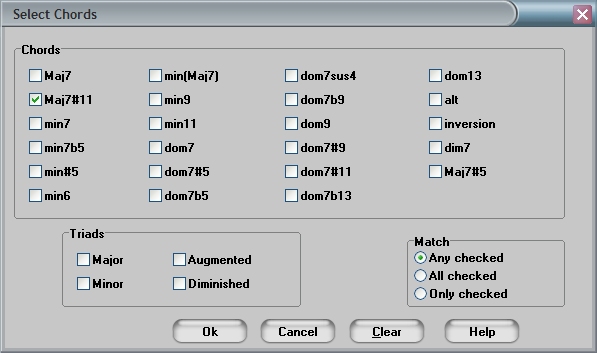
THoTH Tutorial 1
This tutorial will suggest some ways to use THoTH in your teaching/learning of scales, modes and chords.
Contents of this file:

The first step in working with modes of major is to work with tunes that are modal vamps, such as "Impressions", "So What," or "Mr. P.C." These tunes use only the Dorian mode.
The next step is to work on tunes that use only several modes of major, and modulate to several different keys. Examples include "Four," "Tune-Up," and "Here's That Rainy Day.". These tunes can be a good starting point for students who know only major scales and want to get started improvising. THoTH can produce a chord-scale analysis for these tunes. Select "Here's That Rainy Day" from the song list and click the Detail button, then, when the song page opens, click the Analysis button. A window will open showing THoTH's analysis of the chord progression.
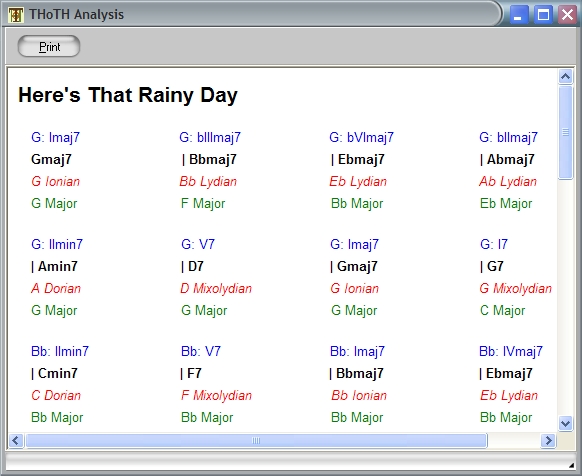
A good preparation for improvising is to "walk through the chord-scales." To see an example of this, select "Here's That Rainy Day" from the song list, click on the Detail button to open the song page, click on the "lesson rainy scale.pdf."
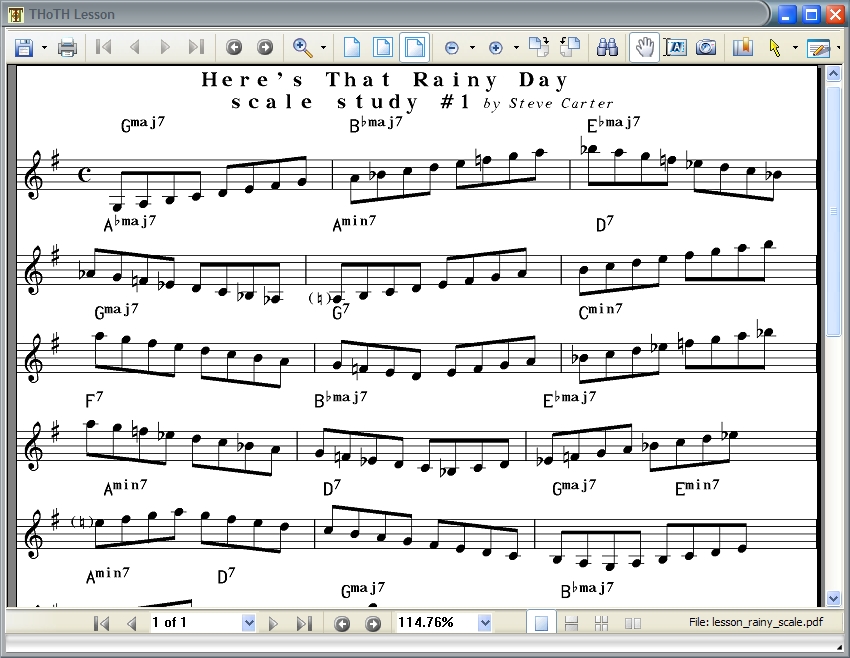
The idea is to begin on a chord tone, and play constant eight notes over the changes. When the key changes, move to the closest note of the new scale and keep going through that scale. Choose lowest and highest notes to limit the exercise to one position or a combination of positions.

Once a student has learned a couple of fingerings for the Real Melodic Minor scale (also known as Jazz Minor), it's a good idea to start working on tunes that use the modes of Real Melodic Minor in just a couple of places. A good example is "Dindi." Select Dindi from the song list and click the Detail button, then, when the song page opens, click the Analysis button. A window will open showing THoTH's analysis of the chord progression.
You'll see a Db9 chord in measure six. You'll see that THoTH analyzes this as IV9 in the key of Ab. The chord scale is Db Lydian Flat7, which is a mode of the Ab Real Melodic Minor scale. This is a very common sound and jazz. It's a good idea to make a vamp out of the first eight bars of "Dindi." The student can improvise using Ab major over every chord except the Db9, switching to Ab Real Melodic Minor for that chord.
If you go to the Lessons tab on the "Dindi" song page, you'll see a lesson entitled "lesson_dindi_scale_1.pdf." This is an exercise I wrote to demonstrate the concept of "walking through the chord-scales." The purpose of the exercise is to be able to play steadily through the changes, using the correct modes. I start on a chord tone and move in constant eight notes. When the chord changes, I go to the closest note that fits that chord, and continue. I selected C above the staff as my highest note, and G below the staff as my lowest note, so when I hit one of these "end points" I reverse direction. You'll notice the Db Lydian Flat7 scale in measures 8 and 14. So if you arrange the analysis page and the exercise page on the screen, you can look at the chord-scale names, and the notes and see how it all works.
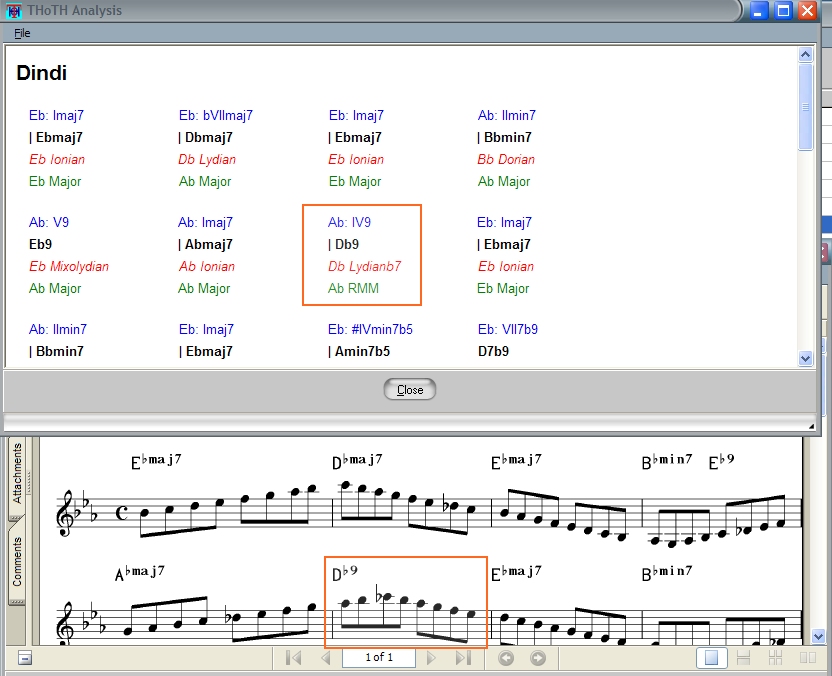
"Blue Bossa" is a good introduction to the most common mode of Harmonic Minor, the Mixolydian Flat9 Flat13.
Open the song form for "Blue Bossa" and click on the analysis button. You'll see that all the modes used in this song are derived from major, with the exception of the Mixolydian Flat9 Flat13 on the G7b9 chord. You might find it strange that I analyze this minor tune as if it were major, but remember that we are doing a chord-scale analysis, not a functional harmonic analysis.
Most students will find it quite easy to play the Eb major scale over the Cm7 and Fm7 chords, and to get the appropriate blues flavor. Students without much experience with jazz harmony may not be familiar with the min7b5 chord, but will quickly recognize the sound of the minor II-V. The Dmin7b5, being the VII chord in Eb, does not introduce any new notes.
The only new note introduced by the G7b9 is the Bb. If you change the Bb of an Eb major scale to a B-natural, you get a C harmonic minor scale. Since G is the fifth note of this scale, our chord-scale is G Mixolydian Flat9 Flat13.
Bars 9 through 12 are just a II-V-I in Db, using modes of the major scale.
So "Blue Bossa" is a great tune to tie together blues, rock, jazz and chord-scale theory.
You can use THoTH to help you select songs that use the chord types a student is learning.
If a student has a limited chord vocabulary, you can select songs that use only one type of chord. For example, to find songs that use only dominant seventh chords, click on the Search menu, and then click Chords. Check the box next to "dom7" and in the Match area, check the "Only checked" radio button.
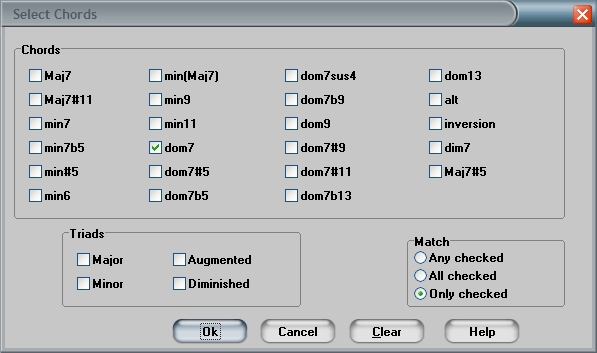
You'll get a list that shows "Bessie's Blues" -- you expect this search to show blues tunes -- but it also shows tunes that you might not think of: "Leroy the Magician" and "Sing Me Softly of the Blues." These are pretty hip tunes for a student to be able to play with only one chord type!
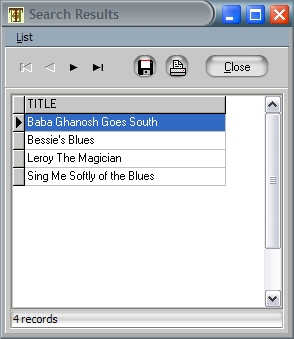 )
)
You might be able to introduce your student to some new sounds by searching for songs that use a certain type of chord. For example, search for Maj7#11, and set the match button to "Any checked."


This could lead into a discussion of using the Lydian mode for improvising.